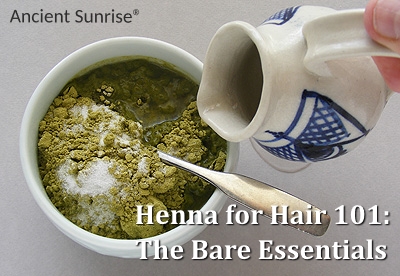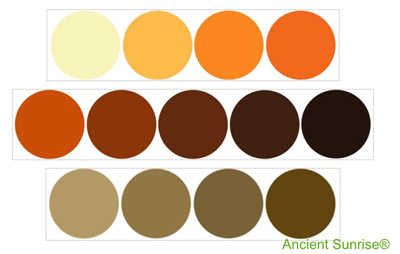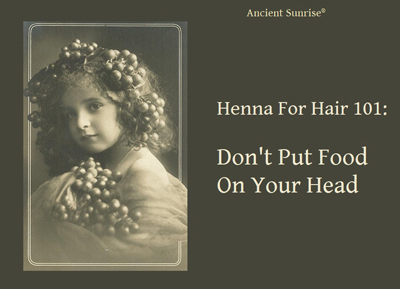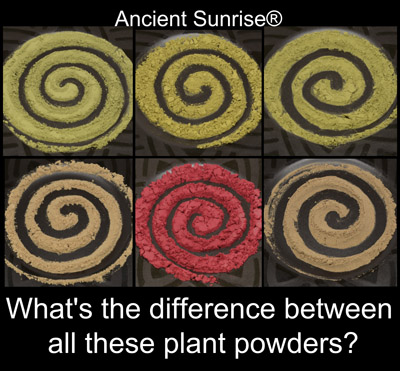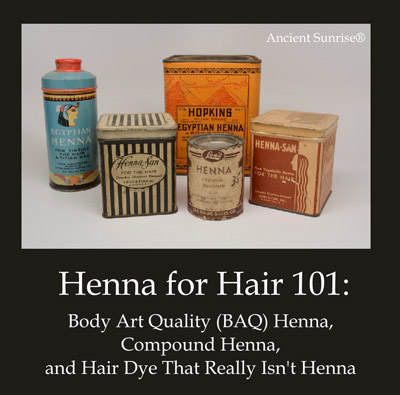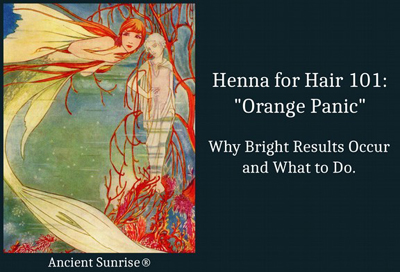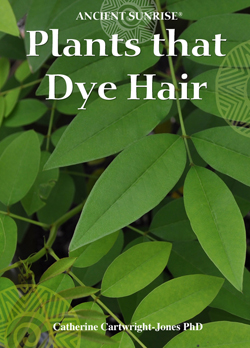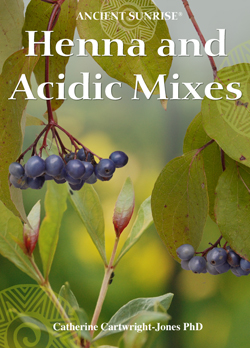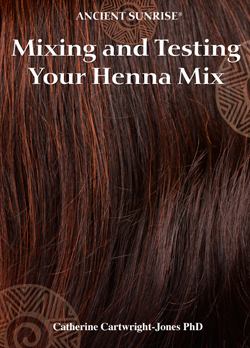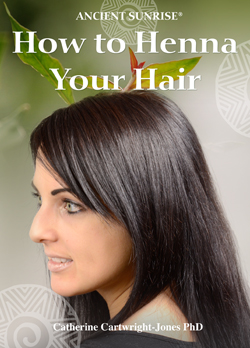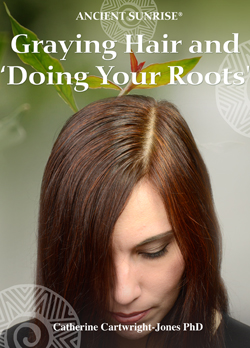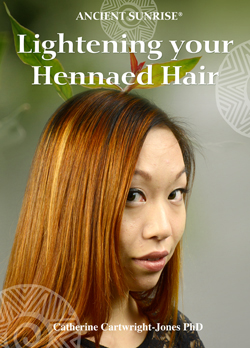How to Create Your Henna Mix Are you allergic to chemical hair dye? Do you want to cover your gray? Learn to dye your hair with safe, pure Ancient Sunrise® henna, indigo and cassia mixed with fruit juices. Learn to mix dozens of colors, and your PERFECT color with the free Ancient Sunrise® Henna for Hair ebook. |
     For five thousand years, women knew how to create the perfect henna mixes for hair. Each woman probably learned the mix from her family or a friend, and used only plants growing in the area. When chemical dyes were introduced, the intimate person-to person transmission of henna knowledge stopped.      Pre-packaged henna with unlisted ingredients, chemicals, and chemical salts became consumer products. Adulterated mixes comprise over 90% of the henna hair dye market and have given henna a terrible reputation because they cross-react, often disastrously, with oxidative hair dyes. You can do better. Ancient Sunrise® will help you. |           Working with plant dyes does not quite follow the color theory of crayons or chemical dyes. Plant dye molecules are different sizes and shapes, and those shapes fit differently on the dye molecule attachment points of keratin molecules, just as different tetromino shapes lock down in the game of Tetris. Plant dye molecules also change with time, heat, oxidation and pH. The acidic fruit juices you mix into henna also vary the dye color when they contain anthocyanins or anti-oxidants. |
|
How do you get all of these colors from three plants, some fruit, and some time? We can show you how!
Once, each woman knew the perfect henna mix for her hair. She probably learned the mix from her family or a friend. When chemical dyes were introduced, the intimate person-to person transmission of henna knowledge stopped. Some people get info about henna on packages for sale, and the information is is always woefully inadequate. Pre-mixed henna colors often contain unlisted additives, chemicals, and adulterants. Simply mixing all the powders together will never work very well; the dye chemistry is conflicted. Other people look for information about henna online, and most of the henna info online is dead wrong. I wrote the Ancient Sunrise® Henna for Hair ebook to provide people with thorough, accurate information about henna so they can have lovely, healthy hair. This may seem complicated and confusing at first, but we'll answer your questions! I think you deserve the best research, solid science, and reliable techniques, and not something dumbed down. If you're confused, or just want convenience, we have kits that have everything you need. Ancient Sunrise Henna for Hair Kits If you want to learn more and save money by buying the supplies separately, or in bulk, keep reading. 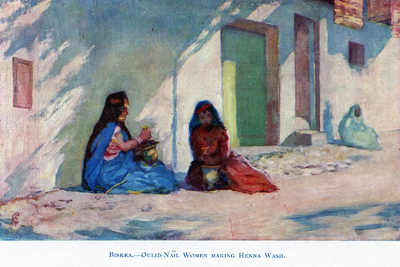 |
When it comes to henna for hair, the simplest mix is the best. Having a basic understanding of the nature of henna and other plant dye powders will lead to beautiful results. Henna is different from boxed dye, so some nervousness or confusion is normal. The internet is filled with conflicting information which makes henna seem more complicated than it is. Ancient Sunrise is built upon decades of research with the goal of providing knowledge and high quality product to the public. The purpose of this article and others in the Henna for Hair 101 series is to educate new henna users so they will feel confident in their knowledge, and excited to begin. Henna has been used for centuries across the world, in the Middle East, Northern Africa, and South Asia, where the lawsonia inermis plant grows in hot, arid climates. Henna as a hair dye has grown in popularity as many choose to move away from conventional hair dyes. And for good reason. PPD (para-phenylenediamine) and related chemicals are common ingredients in the majority of commercial hair dyes, and can cause serious reactions which will worsen with each exposure. 100% pure BAQ henna is an effective and permanent way to get a beautiful hair color that strengthens and conditions the hair rather than damaging it. Pure henna is safe to use. Adverse reactions are extremely rare. Click HERE or on the image above to learn the absolute basics before you start. |
|
The quick and dirty facts about henna for hair are the following: Henna by itself stains keratin a range of shades between copper and dark auburn. Indigo darkens and browns these shades, and cassia lightens these shades, adding golden tones. Equal parts henna and indigo will result in a medium brunette on most. More indigo will result in darker and darker shades of brunette. Equal parts of henna and cassia results in bright, fiery tones of copper and orange. More cassia will result in lighter and brighter tones of strawberry blonde. Henna first, then indigo second in a two-step process results in a shiny jet black color. Click HERE or on the image above to learn more. |
Well… you can if you really want to, but please keep it out of your henna. If you’ve surfed around the internet looking for information on dyeing hair with henna, chances are that you’ve found dozens of articles and videos on how to create a henna mix for your hair, and many of them have told you to add any of a variety of things into the mix. How do you decide which to use? Should you add coffee? Should you add coconut milk? Eggs? Spices? Oils? Yogurt? Beet juice? The answer is no. Click HERE or on the image above to learn why. |
|
|
|
|
People frequently ask what they should or should not do to their hair before applying henna. Does hair need to be clean, or left unwashed? Can it have conditioner on it? Should it be wet or dry? As henna works differently from conventional hair dyes and treatments, these questions are valid. This article will explain the best ways to prepare your hair for your henna treatment to obtain the best results. Click HERE or on the image above to learn how to prepare your hair for henna. |
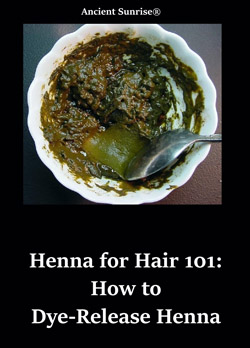 For the best coverage and permanent results, it is important to mix henna powder with a mild acid and allow the paste to sit for a period of time. This process is referred to as “dye-release.” Improper dye release can lead to weak stains that fade over time, and undesired color results. |
|
“Orange Panic” If you are new to using henna for hair or have just tried a new mix you may be startled by the color of your hair upon rinsing out the henna paste. You may have been going for a deep red, or even a brunette tone, but now you think you look more like Bozo the Clown or Carrot Top. This phenomenon is commonly referred to as “Orange Panic” within the henna for hair community. Luckily, it is completely normal to see a brighter color at first, and this brightness will go away with time. Henna’s dye molecule is naturally orange or copper in tone. Deepening occurs as the dye oxidizes and settles permanently into the keratin. Click HERE to learn more about the oxidation process of henna and hair. |
For those who are new to applying henna, this process may seem daunting. It is actually quite simple and fun, especially after you get the hang of it. Make sure your floor is covered, and that you have towels on hand to clean up messes. I like to put some music on to help pass the time. If you feel you are unable to apply the paste by yourself, see if you can enlist the help of a friend, or find a stylist who is open to applying the paste for you. These stylists use Ancient Sunrise® Henna for Hair in their salons. Some stylists, even if they are not on this list, are familiar with henna for hair and willing to apply it on their clients for a fee. If your stylist is interested in using Ancient Sunrise® products in their salon, let them know that they can get a special discount! Click HERE to learn more about how to apply henna to your hair. Click HERE to watch a "how to" video. |
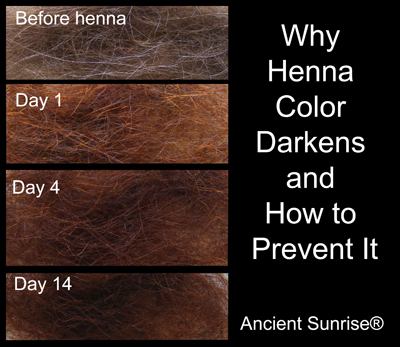 https://www.ancientsunrise.blog/full-coverage-darkening Full Coverage: Why Henna Color Darkens and How to Prevent It Unlike boxed dyes, henna is permanent and does not fade. With continued applications and exposure to heat or mineral buildup, the color darkens. For those who find their color results too bright, darkening with subsequent applications or heat appliances is a handy technique for adjusting their color. For others who are happy with their color and want to keep it, this can be frustrating. Depending on the cause, you may be able to brighten hennaed hair that has deepened and dulled. In other cases, chemical lightening may be the only option. If you love your result and want to keep it, it is best to be proactive in preventing darkening. Click HERE or on the image above to learn to prevent oxidation and darkening. If you want to prevent it. |
 https://www.ancientsunrise.blog/full-coverage-neutral-cool Full Coverage: How to Achieve Neutral or Cool Tones Using Henna for Hair A common concern
voiced by new henna users is that even a henna/indigo mixture will
result in a brunette shade that is too warm for their liking. Many
prefer neutral to cool tones in their hair, as they believe it better
suits their complexions. While somewhat tricky, neutral and cool toned
hair colors are possible using the right combination of henna and
indigo (and sometimes cassia), and the right fruit acid. Because each
person’s hair varies on undertone, porosity, and dye-resistance,
getting the perfect color may take some patience and strand-testing.
Remember that our henna experts are available to talk you through the
process, and help you troubleshoot if needed, until you achieve your
perfect color.
Click HERE or on the image above if you want to learn to reduce the red color of henna as much as possible. |
 https://www.ancientsunrise.blog/full-coverage-blonde-how-to Full Coverage: How to Dye Hair Blonde with Plant Dye Powders Henna dyes hair
shades of red. Add indigo, and you’ll get brunettes. But what if you
have gray, white, or light blonde hair and you’d like to keep your hair
light? Mixes that have a higher amount of cassia, and a smaller amount
of henna and indigo will help you achieve blonde tones that range from
sun-kissed straw to deep, “dishwater” blonde. These mixes are great for
those who don’t want red, brown or black hair, and for those who wish
to tint their grays to blend naturally with their root growth. This
article will cover everything you might need to achieve your ideal
blonde.
Click HERE or on the image above if you want to brighten your greying or bleached blonde hair |
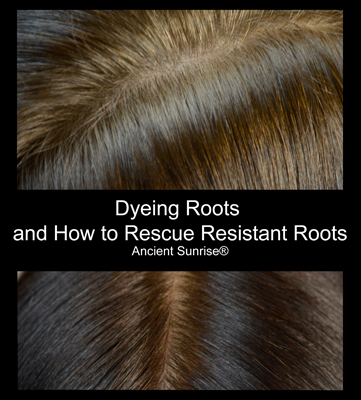 https://www.ancientsunrise.blog/full-coverage-roots Full Coverage: Dyeing Roots and How to Rescue Resistant Roots After the first
initial application(s) of henna, there is no need to continue dyeing
the full length of your hair each time. Because henna stains hair
permanently and does not fade, repeated applications will darken the
color over time as henna saturates the hair more and more. If you are
not concerned with darkening, or intend to darken the color, you are
welcome to continue applying henna to the full length of your hair
until you achieve the desired effect. Repeated applications will not
cause damage; in fact, additional henna will continue to strengthen and
thicken the hair.
Click HERE or on the image above if you want to learn to dye your roots and to get better results with resistant gray. |
|
This chapter discusses henna, indigo, and cassia, (lawsonia inermis, indigofera tinctoria, and cassia obovata) and the chemistry of each of these dye plants. Understanding the botany of these plants will help you understand how to get the best results from your henna hair dye. Index of specific topics in this chapter: Page 3: Three Plants Dye Hair: Henna, Indigo, and Cassia Page 5: Henna, Lawsonia Inermis Page 15: Indigo, Indigofera Tinctoria Page 21: Cassia Obovata What is the difference between Cassia Obovata and Cassia Auriculata? How do you use Cassia Auriculata as a hair conditioner and toner?
"Ancient
Sunrise® Henna for Hair" is a FREE ebook researched and written by
Catherine Cartwright-Jones PhD, a researcher who focused her graduate
and doctoral work on henna. Ancient Sunrise® Henna for Hair is meant to
help you understand how to dye their hair without chemicals, to
protect your own health and the health of the planet you live on, to
correct the misconceptions that have lead to chemical hair dye industry
replacing henna, and to dispel the abundant misinformation about henna. |
This chapter discusses the necessary chemistry of mixing henna and cassia with a mildly acidic liquid. This chapter discusses several sources of fruit acids, and how each has a different effect on henna. Index of specific topics in this chapter: Page 3: Henna, Cassia, and Mildly Acidic Mixes Page 5: Citrus Fruits and Citric Acid Page 7: Ancient Sunrise® Amla, Emblica Officinalis Page 8: Acids with Anthocyanins and Antioxidants Page 11: Ancient Sunrise® Kristalovino and Ancient Sunrise® Malluma Kristalovino Page 13: What Acids Do You Have Around the House? Page 14: Coffee, Wine, Yogurt, Oil and Eggs: Don’t Bother |
|
This chapter discusses the mixing, dye release, formulation, and testing of a wide range of non-chemical permanent colors from henna, indigo, and cassia. This chapter includes step-by-step instructions to produce the color you want for your hair. Index of specific topics in this chapter: Page 3: What Difference Does Your Hair Color Make? Page 5: Formulate Your Mix; Mix Your Paste Page 8: Dye release: When Will the Henna Paste be Ready?
Need your Henna in a Hurry? What Does Henna Dye Release Look Like? Page 17: Mix Henna and Indigo for Brunette Colors Page 21: Mix Ancient Sunrise® Indigo to Dye Hair Black over Henna Page 22: Test Ancient Sunrise® Paste on your Hair What is the difference between Cassia Obovata and Cassia Auriculata? How do you use Cassia Auriculata as a hair conditioner and toner? |
Ancient Sunrise® Chapter 8: How to Henna Your Hair This chapter has step-by-step instructions for first time users dyeing hair blonde, red, brunette or black with henna indigo, and cassia. Index of specific topics in this chapter: Page 3: How Do You Henna Your Hair for the First Time? Page 7: Use an Ancient Sunrise® Cassia-Henna Mix to Repair Bleached Hair and Add Color Page 13: Apply Ancient Sunrise® Cassia for Conditioning and Minimal Color Change Page 19: Apply Ancient Sunrise® Henna to Bleached Hair Page 23: Dye Hair Warm Black with a One Step Henna-Indigo Mix Over Chemically Dyed Graying Blonde Page 48: Dye Graying Light Brown Hair Black with the Two-Step Henna-Indigo Process Page 42: Henna Chemically Dyed Hair Shop for samples of Ancient Sunrise® henna, indigo, and cassia to test on your hair: Click HERE Shop for henna, indigo, and cassia from Ancient Sunrise® |
|
This chapter has step-by-step instructions for maintaining your gray roots as they grow in; dyeing them red, brunette, or black. Index of specific topics in this chapter: Page 3: Doing Gray Roots with Ancient Sunrise® Henna Page 10: Covering Gray Roots with an Ancient Sunrise® Henna-Indigo Mix Page 14: Dye Graying Blonde Roots Warm Black Page 18: Dye graying roots black with the Ancient Sunrise® two-step process of henna and indigo Page 32: Dyeing Graying Roots at Home Shop for samples of Ancient Sunrise® henna, indigo, and cassia to test on your hair: Click HERE Shop for henna, indigo, and cassia from Ancient Sunrise® |
This chapter discusses the application of henna
over chemically lightened hair, and chemically lightening
hennaed hair.
The outcome of your Ancient Sunrise® dye will be a color overlay over your base color, unless you work with bleach. Yes, you can lighten your hair before and after using Ancient Sunrise® henna! This chapter demonstrates the technique of highlights with henna and foils. |
Do you want to henna your relaxed or natural hair or your locs?
Here's how to do this, here's why Ancient Sunrise® does it best. 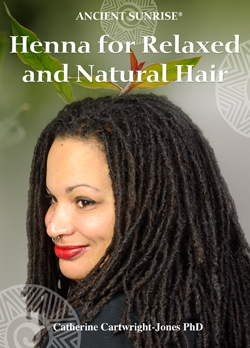 Ancient Sunrise® Chapter 11: Henna for Relaxed and Natural Hair This chapter contains step-by-step instructions
for using henna, cassia, and indigo to dye relaxed hair, natural
hair, and locs.
Index of specific topics in this chapter: Page 3: Henna on Relaxed and Natural Hair Page 5: Cassia and Relaxed Hair Page 12: Henna and Natural Hair Page 21: Two-Step Henna-Indigo Black and Locs Shop for henna, indigo, and cassia from Ancient Sunrise® |
Not every person gets perfect results on the first try, but everyone
can achieve perfection. Here's your guide to troubleshooting.
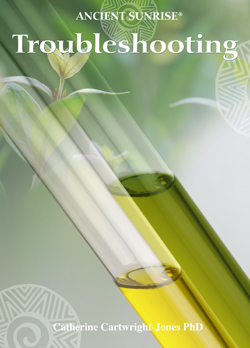 This chapter provides answers to the most frequent questions from people who henna their hair; these include problems with hard water, slight adjustments in color, getting complete and permanent color, and the occasional surprise. Index of specific topics in this chapter: Page 3: Why Are My Cassia and Henna Turning Brownish, or Worse? (hard water problems) Page 7: Henna and You I Itch
Why Is My Urine Green the Morning After Applying Henna? (harmless but startling) I Don’t Have Enough Time My Hair Feels Dry After Henna I Have a Headache Page 7: Understanding the Nature of Henna My Hair Smells Like a Wet Dog
Indigo Turned My Hair Green My hennaed hair is getting too dark I Just Hennaed My Hair and It Is Too Orange I Don’t Know What I Have I Made a Mess I Mixed My Indigo, Got Interrupted, and Forgot About It My Forehead and Ears are Orange My Hands are Orange I Hate This, I Want My Chemicals Back Page 10: Troubleshooting Paste and Application I Missed a Spot.
I Want to Slightly Change My Hair Color My Roots didn’t Take Up Enough Color I Mixed My Paste and it’s Too Tunny I Mixed My Paste and It Is Too Thick I Mixed My Henna, Got Interrupted, and Forgot About It |
|
Join Facebook's Ancient Sunrise® group to talk to other people who have used Ancient Sunrise® products to permanently, perfectly, dye their hair and cover their gray. If you are a stylist who would like to offer permanent hair color with NO para-phenylenediamine to your clients who are allergic, pregnant, or whose physicians have told them to stay away from chemicals ... or if YOU have become sensitized to PPD ... call us toll-free at 1-855-MEHANDI! We'll help you learn to use chemical-free hair dye. You can be eligible for a 25% discount on products. Ask about our stylists' training program, discounts and support: salons@mehandi.com |
Call customer service to get professional help finding your perfect color: (USA) 855 - MEHANDI or 855 - 634 - 2634 and 330 - 673 - 0600 We also have online chat: click HERE for more info. If our phones are busy, email info@mehandi.com, and we'll call you! |
